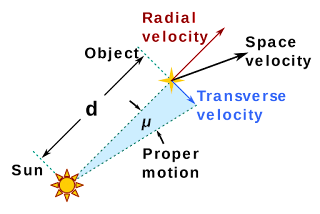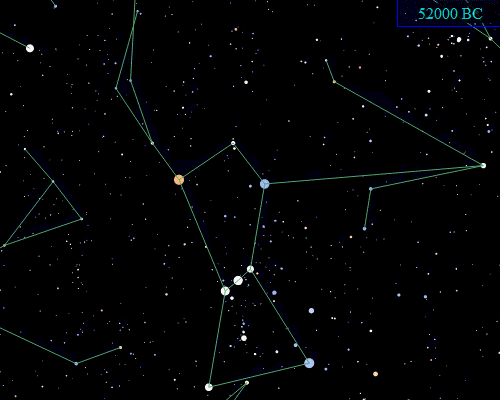The Changing Constellations
The proper motion of a star (μ) is its apparent movement as observed against more distant background stars, measured in terms of seconds of arc per year. In other words, proper motion measures the relative motion of stars or other celestial objects against the background of more distant stars. We need not highlight the simple fact that all things move relative to all other things. Our universe carries no concept of absolute rest/motion. The relative velocity of some particular star (with respect to the Sun), also known as its space velocity, can be broken down into two vector components. One is the star's radial velocity with which it moves away from the Sun and the solar system, and the other is the transverse velocity perpendicular to the line of sight drawn straight from the Sun to the targeted star, with which it moves across the celestial plane (the sky). Since proper motion relates directly to an object's space velocity or true velocity, as sometimes called, the former is not measured with respect to the Earth but from the reference frame of the solar system in which the Sun stands stationary. In fact, proper motion is determined relative to the barycenter of our solar system. By suitable coordinate transformations, a familiar tool in mathematics, we can find out a star's motion relative to the center of the Milky Way Galaxy.
 |
| Image Credits: Public Domain, via Wikimedia Commons. |
Referring to the schematic diagram here, we can decompose space velocity into two perpendicular vector components, the radial velocity and the transverse velocity, and then write as follows:
In order to derive an expression for proper motion, let us assume that at any moment, let d be the straight line distance between the Sun and the target star. The radial velocity of the earmarked star can be easily determined using the Doppler shift of light. If the star moves farther outward along the line of sight, its spectral lines will shift towards the redder end of the visible electromagnetic spectrum. The opposite happens if the star aces closer to the Sun along the line of sight, and the spectral lines shift towards the blue end. Using the Doppler formula given below, calculating the radial velocity becomes straightforward.
λ' measures the magnitude of the spectral shift, λ gives the rest wavelength, c is the velocity of light in vacuum, and v stands for the radial velocity. For the transverse velocity, we require two separate observations of the relative position of the target star, taken at an interval of exactly one year. Assuming the star moves across the celestial plane, the transverse component of velocity being vₜ, in one year, its angular shift (𝜇) in position can be expressed in terms of the following relation derived using simple trigonometry.
If μ is very small, then
Thus, we see that the proper motion results only due to the star's transverse velocity. For example, a star located 100 parsecs from the Sun, roughly 326 light-years distant, having a proper motion of 0.1''/year (0.1 arc seconds per year), yields a tangential velocity of 47.4 km/s. Knowing the radial and transverse velocity allows us to determine the true space velocity of a celestial body (some particular star) as it moves through interstellar space with respect to galactic coordinates. Stars come with space velocities in the order of some 100 km/s. Barnard's star, for example, has a space velocity of 142 km/s.
The closer a star is to the Sun, the greater its proper motion, i.e., the larger is its angular shift over the course of a year. Conversely, the farther out a star is, the lesser will be its proper motion. Very distant stars show no measurable proper motion, just like parallax, and they begin to fall into the category of background stars. Because stars move ever slowly, it takes decades, even centuries for a discernible shift to show up in their relative positions. Proper motion is a cumulative effect. It adds up step by step over the years, so after sufficiently long intervals, the star appears farther out from its original position.
This gif shows how the Orion constellation may have changed over the past 50,000 years and how it may similarly change in the next 50,000.
 |
| Image Credits: Public Domain, via Wikimedia Commons. |
Likewise, this shows the Big Dipper or constellation Ursa Major as it could have appeared 100,000 years ago and what it could be 100,000 years later.
The discovery of proper motion is generally associated with the English astronomer Edmund Halley, who became posthumously famous for ''Halley's comet''. In 1718, while going through the star charts left behind since the time of ancient Greek astronomers like Hipparchus and by his immediate predecessors, Halley noted that the relative position of the three particular stars, Arcturus, Sirius, and Aldebaran, was quite off from his contemporary measurements. Twenty years later, in 1738, Giovanni Domenico Cassini, an Italian astronomer of similar stature as Halley, confirmed the same.





Comments
Post a Comment